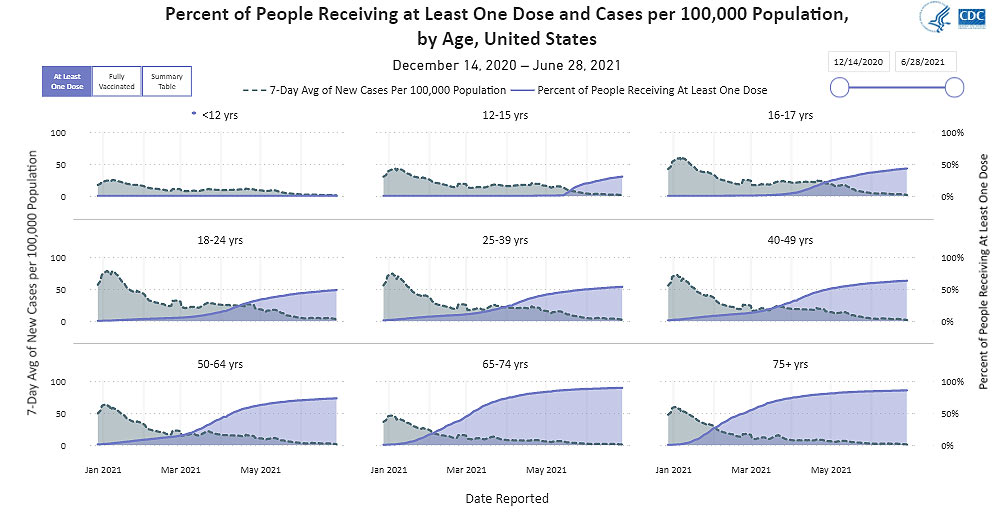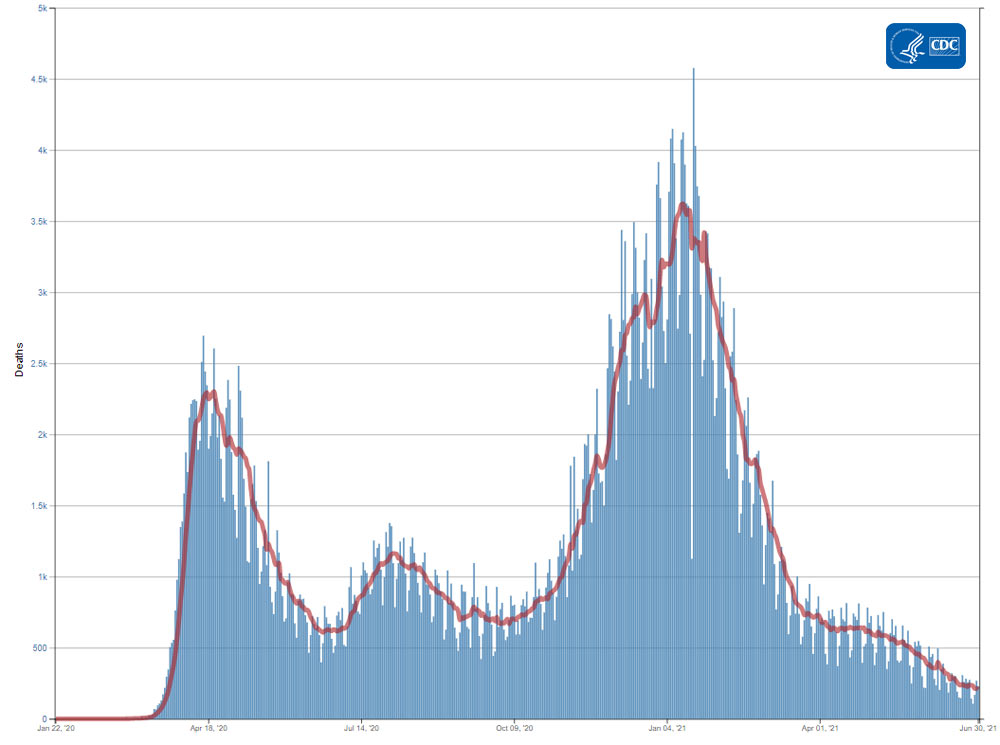Recommendations for Fully Vaccinated People
COVID-19 Homepage

Freedom from the Virus
Interpretive Summary for July 2, 2021
Freedom from the Virus
The United States has made tremendous progress in the fight against COVID-19. As of July 1, 54.6% of the U.S. population had received at least one dose of a COVID-19 vaccine. At the same time, work remains to be done to reach freedom from the virus. COVID-19 cases are increasing in some parts of the country, and on June 23, 2021, the United States surpassed 600,000 total deaths from COVID-19. Additionally, vaccination rates among people ages 18-29 remain low, and a recent CDC report showed intent to get vaccinated was lowest among adults ages 18-39. Unvaccinated people are at serious risk of getting the virus and spreading it to others.
The emergence and spread of variants also have the potential to chip away at our nation’s progress to end this pandemic. On June 15, 2021, CDC announced classification of the SARS-CoV-2 variant B.1.617.2 (Delta) as a variant of concern because it spreads more easily. The spread of the more transmissible B.1.617.2 variant combined with the U.S. population that remains unvaccinated leaves many people at risk of infection. With B.1.617.2 now spreading across the country and infecting people worldwide, it’s more important than ever that all eligible people get vaccinated as soon as possible.
The COVID-19 vaccines authorized for use in the United States offer protection against all known variants, including the B.1.617.2 variant. Getting vaccinated will protect you and the people you love. COVID-19 vaccines are free and available for everyone ages 12 and up. They are nearly 100% effective against severe disease and death, meaning nearly every death due to COVID-19 is preventable. No matter your age, or your health history, until you’re fully vaccinated*—you are at risk of infection. By getting vaccinated and encouraging those around you to do the same, you can safely engage in activities you enjoyed prior to the COVID-19 pandemic. Get vaccinated, help others get vaccinated, and use prevention measures if not fully vaccinated so we can all celebrate our freedom from the virus.
* People are considered fully vaccinated 2 weeks after their second dose in a 2-dose series (such as the Pfizer or Moderna vaccines), or 2 weeks after a single-dose vaccine (such as Johnson & Johnson’s Janssen vaccine). If you don’t meet these requirements, regardless of your age, you are not fully vaccinated. Keep taking all precautions until you are fully vaccinated.
Note to readers: To find a vaccine provider near you, visit Vaccines.gov or your state or local public health department website. You can also text your zip code to 438829 to get 3 locations near you with vaccines in stock. If you prefer your information in Spanish, text your zip code to 822862. You can also call the National COVID-19 Vaccination Assistance Hotline at 1-800-232-0233 to get help in English, Spanish, and more than 150 other languages. It also has a TTY line to support access by hearing impaired callers. If you or someone you know is hesitant about COVID-19 vaccination, CDC has information and answers to frequently asked questions to help inform the decision.
Reported Cases
The current 7-day moving average of daily new cases (12,514) increased 9.1% compared with the previous 7-day moving average (11,472). Compared with the highest peak on January 10, 2021 (252,905), the current 7-day average decreased 95.0%. A total of 33,496,454 COVID-19 cases have been reported as of June 30.
33,496,454
Total Cases Reported
33,496,454
Total Cases Reported
12,514
Current 7-Day Average*
12,514
Current 7-Day Average*
11,472
Prior 7-Day Average
11,472
Prior 7-Day Average
+9.1%
Change in 7-Day Average since Prior Week
+9.1%
Change in 7-Day Average since Prior Week
*Historical cases are excluded from daily new cases and 7-day average calculations until they are incorporated into the dataset for the applicable date. Of 72,725 historical cases reported retroactively, 810 were reported in the current week and 1,034 were reported in the prior week.
Daily Trends in COVID-19 Cases in the United States Reported to CDC

7-Day moving average
SARS-CoV-2 Variants
Multiple variants of the virus that causes COVID-19 are circulating globally and within the United States. To date, four variants have been classified as a variant of concern (VOC). Nowcast estimates* of SARS-CoV-2 cases caused by these VOCs for the two weeks ending June 19 are summarized here. Nationally, the proportion of cases attributed to B.1.1.7 (Alpha) is predicted to decrease to 47.8%; B.1.617.2 (Delta) proportion is predicted to increase to 26.1%; P.1 (Gamma) proportion is predicted to increase to 14.5%; and B.1.351 (Beta) is predicted to decrease to 0.3%. Nowcast estimates predict that B.1.1.7 (Alpha) proportions will be less than 50% in HHS regions 1, 2, 7, 8, 9, and 10. B.1.617.2 (Delta) is predicted to increase in all regions and to be more than 50% in regions 7 and 8. P.1 (Gamma) is predicted to be more than 20% in regions 1 and 10; and B.1.351 (Beta) is predicted to be below 1% in all HHS regions.
*The median time from specimen collection to sequence data reporting is about 3 weeks. As a result, weighted estimates for the most recent few weeks may be unstable or unavailable. CDC’s Nowcast is a data projection tool that helps fill this gap by generating timely estimates of variant proportions for variants that are circulating in the United States. View Nowcast estimates on CDC’s COVID Data Tracker website on the Variant Proportions page.
Testing
The percentage of COVID-19 NAATs (nucleic acid amplification tests) that are positive (percent positivity) has increased from the previous week. The 7-day average of percent positivity from tests is now 2.0 %. The 7-day average number of tests reported for June 18-June 24 was 598,859, down 8.1% from 651,734 for the prior 7 days.
468,067,207
Total Tests Reported
468,067,207
Total Tests Reported
598,859
7-Day Average Tests Reported
598,859
7-Day Average Tests Reported
2.0%
7-Day Average % Positivity
2.0%
7-Day Average % Positivity
1.8%
Previous 7-Day Average % Positivity
1.8%
Previous 7-Day Average % Positivity
+14.5%
Change in 7-Day Average % Positivity since Prior Week
+14.5%
Change in 7-Day Average % Positivity since Prior Week
COVID-19 NAAT Laboratory Test 7-day Percent Positivity by State/Territory
Vaccinations
The U.S. COVID-19 Vaccination Program began December 14, 2020. As of July 1, 328.2 million vaccine doses have been administered. Overall, about 181.3 million people, or 54.6% of the total U.S. population, have received at least one dose of vaccine. About 155.9 million people, or 47.0% of the total U.S. population, have been fully vaccinated.* As of July 1, the 7-day average number of administered vaccine doses reported (by date administered) to CDC per day was 334,816, a 45.3% decrease from the previous week.
The COVID Data Tracker Vaccination Demographic Trends tab shows vaccination trends by age group. As of July 1, 88.2% of people ages 65 or older have received at least one dose of vaccine and 78.3% are fully vaccinated. Two-thirds (66.7%) of people ages 18 or older have received at least one dose of vaccine and 57.7% are fully vaccinated. For people ages 12 or older, 63.9% have received at least one dose of vaccine and 54.9% are fully vaccinated.
328,152,304
Vaccines Administered
328,152,304
Vaccines Administered
181,339,416
People who received at least one dose
181,339,416
People who received at least one dose
155,884,601
People who are fully vaccinated*
155,884,601
People who are fully vaccinated*
54.6%
Percentage of the US population that has received at least one dose
54.6%
Percentage of the US population that has received at least one dose
47.0%
Percentage of the US population that has been fully vaccinated*
47.0%
Percentage of the US population that has been fully vaccinated*
+0.9
Percentage point increase from last week
+0.9
Percentage point increase from last week
+1.4
Percentage point increase from last week
+1.4
Percentage point increase from last week
*People who are fully vaccinated represents the number of people who have received the second dose in a two-dose COVID-19 vaccine series or one dose of the single-shot J&J/Janssen COVID-19 vaccine.
Daily Change in Number of COVID-19 Vaccinations in the United States Reported to CDC

7-Day moving average
Hospitalizations
New Hospital Admissions
The current 7-day average for June 23–June 29 was 1,871. This is a 1.1% increase from the prior 7-day average (1,851) from June 16–June 22. The 7-day moving average for new admissions had been generally decreasing from April 19-June 22 but appears to have since plateaued.
2,283,486
Total New Admissions
2,283,486
Total New Admissions
1,871
Current 7-Day Average
1,871
Current 7-Day Average
1,851
Prior 7-Day Average
1,851
Prior 7-Day Average
+1.1%
Change in 7-Day Average
+1.1%
Change in 7-Day Average
The start of consistent reporting of hospital admissions data was August 1, 2020.
Daily Trends in Number of New COVID-19 Hospital Admissions in the United States
New admissions are pulled from a 10 am EST snapshot of the HHS Unified Hospital Timeseries Dataset. Due to potential reporting delays, data from the most recent 7 days, as noted in the figure above with the grey bar, should be interpreted with caution. Small shifts in historic data may also occur due to changes in the CMS Provider of Services file, which is used to identify the cohort of included hospitals.
COVID-NET: Trends in Hospitalizations in Adults
CDC’s Coronavirus Disease 2019-Associated Hospitalization Surveillance Network (COVID-NET) shows that across the entire COVID-19 pandemic, rates of COVID-19-associated hospitalizations in adults ages 18 years and older have been decreasing as the number of vaccinated adults has increased. Rates of COVID-19-associated hospitalizations for adults peaked at 26 per 100,000 people in early January 2021. Since then, rates in this group have fallen considerably. For the week ending June 12, 2021, the rate of COVID-19-associated hospitalization was 2.8 per 100,000 people. For this age group, this is the lowest rate of COVID-19-associated hospitalizations since March 2020.
Rate of COVID-19-Associated Hospitalizations in Adults Ages 18 Years and Older
The Coronavirus Disease 2019 (COVID-19)-Associated Hospitalization Surveillance Network (COVID-NET) is an additional source for hospitalization data collected through a network of more than 250 acute-care hospitals in 14 states (representing ~10% of the U.S. population). Detailed data on patient demographics, including race/ethnicity, underlying medical conditions, medical interventions, and clinical outcomes, are standardized case reporting form.
Deaths
The current 7-day moving average of new deaths (206) has decreased 11.5% compared with the previous 7-day moving average (233). As of June 30, a total of 602,401 COVID-19 deaths have been reported.
602,401
Total Deaths Reported
602,401
Total Deaths Reported
206
Current 7-Day Average*
206
Current 7-Day Average*
233
Prior 7-Day Average
233
Prior 7-Day Average
-11.5%
Change in 7-Day Average Since Prior Week
-11.5%
Change in 7-Day Average Since Prior Week
*Historical deaths are excluded from the daily new deaths and 7-day average calculations until they are incorporated into the dataset by their applicable date. Of 6,181 historical deaths reported retroactively, 13 were reported in the current week and 24 were reported in the prior week.
Daily Trends in Number of COVID-19 Deaths in the United States Reported to CDC

7-Day moving average
- Symptoms of Depression, Anxiety, Post-Traumatic Stress Disorder, and Suicidal Ideation Among State, Tribal, Local, and Territorial Public Health Workers During the COVID-19 Pandemic — United States, March–April 2021
- COVID-19 Surveillance and Investigations in Workplaces — Seattle and King County, Washington, June 15–November 15, 2020
- COVID-19 Vaccination Coverage Among Adults — United States, December 14, 2020–May 22, 2021
- COVID-19 Vaccination Coverage and Intent Among Adults Aged 18–39 Years — United States, March–May 2021
- Disparities in Learning Mode Access Among K–12 Students During the COVID-19 Pandemic, by Race/Ethnicity, Geography, and Grade Level — United States, September 2020–April 2021
Recent COVID Data Tracker Updates
- Addition of “Total Vaccines Administered” (US level only) to the Daily and Total Trends tab to allow for visualization alongside case, death, testing volume, percent positivity, daily vaccination trends and ED visits








